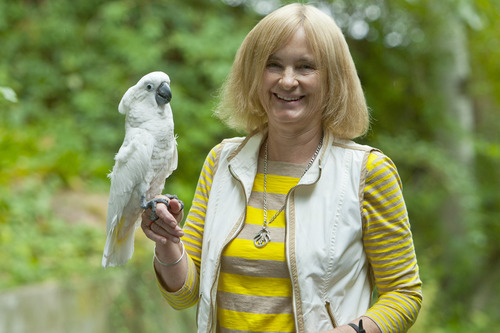This is an archived article that was published on sltrib.com in 2012, and information in the article may be outdated. It is provided only for personal research purposes and may not be reprinted.
The blood of a man doesn't wash off easily —Traditional Enga saying
Firearms were a disruptive technology that turned life upside down 20 years ago in Enga, a province of indigenous tribes in Papua New Guinea. For centuries warring clans had fought with locally-made bows and arrows and often called a truce before anyone was killed. The bloodiest wars rarely claimed more than three or four lives.
After 1990, however, violence spiralled out of control with the advent of high-powered guns, typically made in the United States and stolen from security forces or provided by status-seeking politicians. Wars became increasingly frequent and lethal, according to University of Utah anthropologist Polly Wiessner.
But in a new study published this week in the journal Science, she reports that peace-making customs have reasserted themselves. With the help of compensation rituals involving exchanges of pigs, tribal courts have put an end to much of the fighting that killed 4,816 between 1991 and 2010.
"Social technology from generations past was adapted to contain the impact of adopted modern technology," Wiessner said. "New institutions build on former rules, norms and values. History matters."
Her findings illustrate the importance of the rule of law in maintaining social harmony, but also how effective rules must arise from within the culture, not imposed from without.
Western-style justice, which emphasizes punishment for individual perpetrators, may not resolve disputes in a tribal context, where "restorative justice" is more important than locking someone up, Wiessner argues.
—
The roots of peace • Extreme violence flared historically after small-scale societies "congealed" into large anonymous ones, where people did not know each other and had fewer incentives to maintain peace. It was the rise of modern states that checked violence, as Harvard psychologist Steven Pinker observed in his provocative new book, Better Angels.
But Wiessner believes her study demonstrates the wide variation in how effective pre-state societies are in controlling violence.
Pinker said her observations and "deep theoretical questions" align with the points raised in his book, which argues that we live in the least bloody period in human history.
"Human violence can't be understood by portraying our species either as inherently violent or as inherently peaceable, but rather by analyzing it as the outcome of the tension between violent and peaceable inclinations," Pinker wrote in an e-mail. He shared a podium with Wiessner at a U. conference three years ago.
"The result can be considerable fluctuation over time as new historical developments upset the balance and the impulses that lead to violence (such as dominance and revenge) escape their restraints. But the overall trend is downward — a declining sawtooth."
Wiessner, who joined the U. faculty in 1998, has been studying the Enga since 1985, drawn to Papua New Guinea by her then-husband, who practiced medicine there. Her interest was in preserving the Enga's oral traditions, which she describes in her book Historical Vines.
She has made the histories available to the Enga themselves, helping to establish the Enga Tradition and Transition Center in the provincial capital Wabag.
With about 450,000 speakers, the Enga are the country's largest linguistic group, representing 110 tribes, each with five to 10 clans. Clans have 350 to 1,000 members who trace their roots to a common ancestor.
For millennia, the Enga had been a hunting-gathering society. But with the introduction of the sweet potato 350 years ago, tribes settled, and agricultural surpluses allowed the accumulation of wealth in the form of pigs.
Traditionally Enga women marry outside their clan, Wiessner said.
"This is a key to warfare. Ties through women's marriage are almost as strong as clan ties. You have ties to the clan you are fighting," Wiessner explained in an interview at the Salt Lake City home she shares with a territorial cockatoo called Dude.
"That's where the peacemaking customs came from. There were always people interested in not letting [warfare] go too far."
—
Fighting without rules • But with the influx of modern rifles and munitions, Wiessner saw interclan conflicts increasing exponentially, often leaving dozens dead and villages razed. Even schools and churches were torched.
With collaborator Nitze Pupu, a blind Enga law school graduate, she turned her attention to the tragic social experiment.
She noted that the Enga had access to guns for years, mostly shotguns jury-rigged from water pipes, but avoided using them in war. Clans rarely fought over territory; instead, they went to war to avenge an insult or injury or to show strength.
Village elders had maintained control of the violence until young fighters began carrying assault rifles into battle. After establishing reputations as fearless killers, these "hotheads" were hired by other clans to do their warring. The hierarchy of power inverted, with armed young men on top.
Wiessner likes to recount an exchange between an elder and a young clansman to illustrate this reversal.
"Go away, old man. Your day has come and gone," the fighter tells the elder, who responds, "You have nowhere to go, Rambo, but to the grave."
According to time-honored rules, warriors did not harm women, destroy property, kill opponents' leaders, finish off wounded fighters, mutilate corpses or take revenge after peace was declared.
The collapse of these rules led to "an incredible acceleration of warfare," according to Wiessner.
—
Reining in war • Her conclusions are based on her analysis of data from precolonial wars and 501 recent wars, court records, and interviews with 250 people, many of them young warriors. Wiessner and Pupu also interviewed in secret locations 16 mercenaries — hired guns fighting another clan's war — including a woman who wore an M-16 round on a necklace.
"They knew they would die, but they couldn't envision their own deaths. They couldn't eat, sleep, think straight until they killed," Wiessner said. Fighters relied on magic to protect themselves and indoctrinated younger peers to dehumanize their foes.
"They describe a revenge drive that makes them half man and half animal," Wiessner said. "They talk about fighting in an altered state of consciousness and claim to be enforcing the law in a failed state."
In the 1990s, the average number of people killed in each war was 19. The number of wars reached their height from 2001 to 2003, when 100 wars were waged — but they were less deadly, killing an average of 12 people.
In both time periods, body counts sometimes reached 200 before a war ended. But comparing the first five years of Wiessner's 20-year study period with the last, the proportion of wars with more than 50 deaths fell from 9 to 1 percent. The share with less than five rose from 23 to 74 percent.
Tribal courts, which mediated or ordered exchanges of pigs — rather than jail time — were reasserting their influence. The carnage has dropped off to an average of about 5 deaths per war.
Wiessner believes traditional justice regained control because economic disruption and endless grief was exhausting the Enga, whose vast unarmed majority desired peace. Most New Guineans still live in traditional society practicing subsistence agriculture.
As tribal courts became more active, the social and material rewards for fighters waned, she said, while the promise of acquiring pigs outweighed the transient satisfaction clans gained from revenge.
bmaffly@sltrib.com — About Papua New Guinea
Home to 6.2 million speaking more than 820 tribal languages, Papua New Guinea is the nation covering the eastern half of New Guinea, a resource-rich and mountainous island north of Australia.
From the 1950s until independence in 1975, Papua New Guinea had been colonized by Australians and many of its citizens now practice Christianity.





